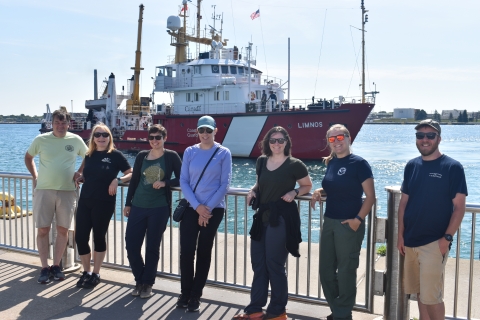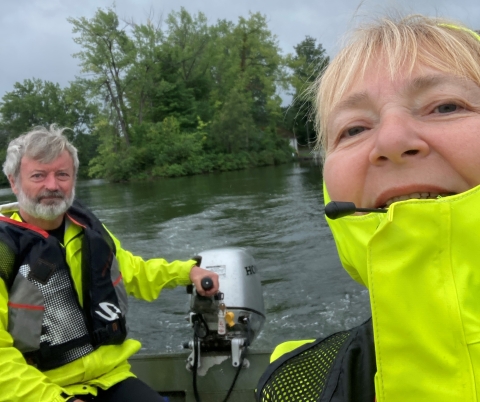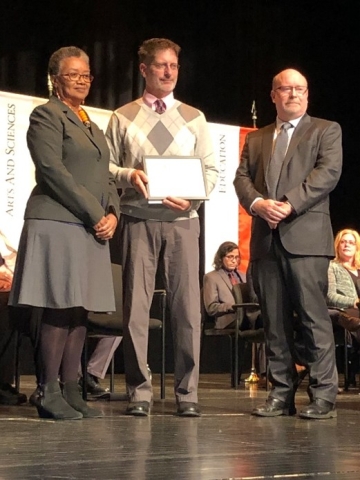
Great Lakes Center Newsletter: Issue 21
November 18, 2022
This issue features our summer fieldwork on the Great Lakes and Oneida Lake, invasive species monitoring for the red swamp crayfish, ANT 389 visiting the Field Station grounds to learn forensic excavation techniques, the arrival of the spotted lanternfly to our area, the WNY PRISM crew teaming up with Craneridge Association to remove invasive plants, and one of our research scientists receiving an award.
GLC samples the Great Lakes amid challenging weather
by Susan Daniel

Researchers from the GLC returned to sampling the Great Lakes as a part of the Great Lakes National Program Office Biology Monitoring Program after various engine troubles arose earlier in the year. Operations were set to be business as usual with a few additional health and safety protocols, including the requirement of COVID-19 vaccinations and ship-wide negative PCR results. The ship, and GLC staff Susan Daniel and Angela Tulumello, set sail out of Milwaukee, Wisconsin on August 27th. Shortly after leaving, the weather turned and thus started the many, many dashes to ports throughout Lakes Michigan and Huron that ultimately extended the survey by a week. To avoid high waves, the ship had to wait out the weather in the Michigan ports of Muskegon, Marquette, and Alpena. The benefit of these many stops was a rare opportunity for researchers to visit cities on the shores of the lakes and stretch out their sea legs!
Highlights from this survey were the beautiful photos of sunrises and sunsets afforded by the bad weather. One of the most interesting and exciting things to happen was a very curious flock of American white pelicans that investigated our ship while sampling a station in Green Bay. The American white pelican is a native waterbird that is closely related to the oceanic brown pelican. The white pelican has been increasing in numbers over the last several years, but only started to nest in the Green Bay area in the 1990s. Overall, the crew was able to successfully collect 150 benthic samples and gained connections that will last a lifetime.

in Green Bay this September.

benthic sample aboard the R/V Lake Guardian.
CSMI Lake Huron survey on Canadian boat
by Alexander Karatayev and Lyubov Burlakova

EAWAG, Switzerland), Allison Hrycik, Annie Scofield (US EPA GLNPO),
Rachel Orzechoswki and Paul Glyshaw (NOAA).
In July 2022, due to the U.S. EPA R/V Lake Guardian being under repairs, we had a unique opportunity to do the benthic survey of Lake Huron on the Canadian Coast Guard coastal research and survey vessel Limnos. At the beginning, this cruise was full of misfires: we lacked some equipment, had to work with a different winch, and there were no marine technicians to help with sample collection. The first week was a challenge, but then everything normalized and we enjoyed the survey and the ship. Kelly Bowen, biologist at Fisheries and Oceans Canada (DFO), along with the Captain and crew were doing everything possible and more to accommodate us. The cooks, especially the pastry chef, were excellent to the point of being dangerous. Anyhow, we survived all the blunders and dangers and storms and collected benthic samples and video images from 130 stations lakewide. During this survey, we set up many new stations in the North Channel, and with our Benthic Imaging System discovered robust dreissenid populations at nearshore areas where we could not collect Ponar samples from hard substrates. We are very thankful to DFO and Limnos for help and hospitality, and thank everyone for excellent results!

Molluscs of Oneida Lake
by Alexander Karatayev and Lyubov Burlakova

in August 2022.
This August, we collected benthic samples in Oneida Lake, which is the largest and best studied inland lake in New York State, with a strong regional, economic, and recreational importance. Frank Collins Baker, a prominent malacologist, conducted one of the world’s first quantitative benthic studies in 1915–1917, finding that Oneida Lake supported the most diverse molluscan communities in the state. Baker provided a very thorough description of his study in two books (Baker 1916, 1918) and several papers. Subsequent studies replicating Baker’s sampling design were conducted at the peak of eutrophication in 1967 (Harman and Forney 1970), and shortly after the invasion of Dreissena in 1991 (Harman 2000) in 1992–95. This produced a unique historical dataset enabling a rigorous assessment of changes in the structure and species richness of the molluscs.
In 2012, we conducted a detailed historical analysis of the mollusc community of Oneida Lake based on our comprehensive lakewide study that year and previous surveys dating back to 1915 (Karatayev et al. 2014). In the early 20th century, the lake had high water clarity, with abundant macrophytes and benthic algae, and supported a diverse molluscan community with 32 gastropod and 9 unionid species. By the 1960s, lake turbidity increased during a period of anthropogenic eutrophication, resulting in a 38% decline in species richness and a 95% reduction in abundance of native gastropods grazing on benthic algae. Following the invasion of Dreissena spp. in 1991 and subsequent increases in water clarity, gastropods in the lake dramatically increased, and by 2012 their species richness and abundance reached levels similar to those reported in 1915–1917. In contrast, filter-feeding unionids were unaffected by increased turbidity during the period of eutrophication but were extirpated by dreissenids.
In 2014, another exotic species was found in Oneida Lake. Round gobies are a bottom-feeder fish from Eurasia known to feed on molluscs and may change their community composition, abundance, and distribution. In August, to investigate their impacts on Oneida Lake molluscs, we conducted a detailed survey of molluscs of the lower South Bay, the best studied part of Oneida Lake, and collected over a hundred samples. Our 2022 sampling design repeats 2012 studies and we hope it will assess the impacts of round goby on the mollusc community. During the 2023 field season, we are planning to expand our survey to the whole lake.

Computational and Integrative Biology, Massachusetts General Hospital,
sorting benthic samples at Cornell Biological Field Station.
Crayfish battles in Amherst
by Dr. Christopher Pennuto

Managing invasive species is always a difficult undertaking, whether the species in question is a hardy, deep-rooted shrub, an aquatic plant able to grow from the smallest stem fragments, or a pugnacious invertebrate like the red swamp crayfish (Procambarus clarkii). This medium-sized crayfish “punches above its weight” among crayfish, and it has a foothold in western New York. Dr. Chris Pennuto, his students, and staff from WNY PRISM have partnered with The Park School in a management effort to prevent further spread of this unwanted addition to the regional crayfish community. Though known from just a single location, there are hydrologic connections to the Niagara River watershed.
Like many crayfish, the red swamp crayfish plays important roles in aquatic ecosystems, serving as food for a variety of predators or aiding in the processing of organic matter. It is a commercially and culturally valued resource in its home range where many a recipe centers on its “lobster-cousin” appeal. However, outside of its native range, a host of ecological damage has been documented and linked to red swamp crayfish activity. Thus, it is a priority management species to prevent further expansion in the region.
Dr. Pennuto and team are considering new management actions to give the local crayfish community an advantage. Part of that action is an intensive trapping effort. Last summer, over 200 animals were trapped from the location, with no apparent reduction in the number caught per trap-night.
Discussions are under way to consider adding large fish predators to the site to help reduce the number of crayfish present, but this has potential drawbacks. Most fish predators large enough to consume red swamp crayfish (like large-mouth bass) will also consume a wide variety of other pond inhabitants like frogs, salamanders, and other fish. Introducing native crayfish that might out-compete red swamp crayfish, a tactic called competitive niche replacement, is also being considered. Unfortunately, this also has potential drawbacks. For example, since the native species in question is a close relative of the red swamp crayfish, it is still unclear if they might hybridize and imperil the native species through biotic homogenization. And other tactics like introduction of sterile males, red swamp-specific pathogens or parasites, or chemical additions are all being evaluated. Stay tuned for updates.
Anthropology class excavations
by Lisa Marie Anselmi, Associate Professor and Chair, Anthropology Deparment, and Mark Clapsadl
Dr. Lisa Marie Anselmi’s Anthropology class (ANT 389 Bioarchaeology Methods) utilized the Field Station grounds for several weeks of intensive hands-on instruction using techniques of forensic excavation of human remains. The staged scenario excavations included one simulated forensic anthropology case and one simulated archaeological burial feature, loosely based on the site of Varna in Bulgaria. The Field Station grounds provided a secure site so that the painstaking work could proceed carefully and slowly and remain undisturbed for the duration of the class. The location also allowed students to learn to excavate a cremation burial (using animal bones) in addition to excavating the scenarios which used teaching casts of human remains.

Spotted lanternfly spotted in WNY PRISM region!
written by Brittany Hernon and Douglas Knoph

Lawrence Barringer, Pennsylvania
Department of Agriculture,
Bugwood.org
Spotted lanternfly (Lycorma delicatula) has spread to the WNY PRISM region. In mid-September, the Department of Agriculture and Markets (AGM) confirmed the presence of spotted lanternfly in Buffalo. Based on a report made to AGM, they conducted surveys in and around the reported sighting and over 100 adults were found.
Spotted lanternfly is an invasive species that feeds on more than 70 plant species, including trees and crops such as grapevine, apple trees, and hops. First found in New York State on Staten Island in August 2020, spotted lanternfly has quickly become a high priority target for the state.
Spotted lanternfly (SLF) adults emerge in July and have eye catching wings with forewings that are grayish with black spots, and hindwings that are red with black spots. Adult SLF begin laying eggs in September and eggs hatch in late April to early May. Surveys for SLF egg masses can be conducted throughout the winter. Nymphs emerge in spring and are black with white spots and turn red with white spots before becoming adults.
If you find SLF in the WNY PRISM region, immediately report the species to AGM. In addition, please follow these simple steps:
- Take pictures of the insect or egg masses, and if possible, include something for size reference.
- If possible, collect the insect in a bag and freeze, or in a jar with rubbing alcohol or hand sanitizer.
- Note the location (street address, intersecting roads, GPS coordinates).

Lawrence Barringer, Pennsylvania
Department of Agriculture,
Bugwood.org
WNY PRISM received ten SLF traps for the 2022 field season from AGM and reached out to land managers and community scientists to help place and monitor these traps. The best way to detect this insect is to set up traps on another invasive species, tree of heaven (Ailanthus altissima). This tree is native to the same area in Asia as SLF, and the insect is drawn towards this species for feeding. The traps are simple funnel traps that use metal screen wrapped around the trunk of the tree to guide SLF into a collection bag. Our dedicated volunteers and partners check the traps bi-weekly, and report back to WNY PRISM with their findings.

checking the SLF trap at Sunshine Park.
Battling invasive species in a quiet wooded neighborhood
by Gwen Alegre, WNY PRISM partner and Chair, Craneridge HOA Woodlands & Habitat Committee

bush honeysuckle from an area selected for treatment.
Two teams came together in mid-June 2022. One was the expert crew from WNY PRISM led by Douglas Knoph. The other was a dedicated group of volunteers representing the Craneridge Association neighborhood in Glenwood, NY. Based on a “reconnaissance” iMapInvasives inventory completed by the WNY PRISM Crew the summer before, the teams converged on a warm, blue-sky morning. Armed with long-arm pruners, powered saws, herbicide drip bottles, and rubber gloves, the teams got to work.
Targets were areas of invasive bush honeysuckle (Lonicera spp., primarily L. morrowii) and the fierce-fighting multi-flora rose (Rosa multiflora). The mission’s objectives were to train the neighborhood team on removal tactics, and then clear two invaded areas so that the Woodlands & Habitat Committee could do replacement planting of native shrubs and perennials in the fall and following spring.
The teams quickly fell into step together and worked shoulder-to-shoulder and (safely) saw-to-saw. They felt triumphant as they made quick progress removing the bush honeysuckle. But then they faced the barbed, ever treacherous multi-flora rose. There was sweat. And blood. Band-aids were offered.
Ultimately, triumph! Thanks to the expertise of the WNY PRISM Crew and the dogged persistence of the Craneridge neighbors who will monitor and manage for regrowth. For next year, volunteers will continue efforts to remove areas of invasive terrestrials, with a new focus on the challenging Phragmites.
The Craneridge Woodlands & Habitat Committee continues our valued partnership with WNY PRISM as an important part of our overall mission, which inspires and educates our residents to improve and maintain a healthy and diverse woodlands and natural habitat. If you’d like to learn more about our neighborhood’s efforts, contact Gwen Alegre.

day removing bush honeysuckle and multi-flora rose from the property.
GLC scientist receives research award
adapted from an article by Brian Kantz that appeared in the Daily Bulletin
Christopher Pennuto, professor of biology and research scientist with the Great Lakes Center, received the President’s Award for Excellence in Research, Scholarship, and Creativity at the 2022 Faculty and Staff Recognition Ceremony. The award highlights his accomplishments in external grant support, his commitment to undergraduate and graduate students, and his publication record. His efforts have resulted in research space that has trained over 30 graduate scholars in aquatic ecology. He also received the President’s Award for Excellence as an Undergraduate Research Mentor in 2011.
Pennuto has been highly successful in funding his research through extramural grants, amounting to more than $7.2 million in funding from state and federal agencies over his career at Buffalo State. Most recently, his leadership to secure state funds in support of operations for the Western New York Partnership for Regional Invasive Species Management (WNY PRISM) office at Buffalo State is particularly notable. This project supports a wide range of management efforts with regional partners and stakeholders, plus public information campaigns to slow the spread of terrestrial and aquatic invasive species in western New York. This great work would not be possible without the impressive efforts and commitments of a great staff. The impressive nature of his work is recognized by colleagues and peers across the region and brings distinction to the college.

President Katherine Conway-Turner and Dean Brian Cronk
at the Faculty and Staff Recognition Ceremony on
October 13.

